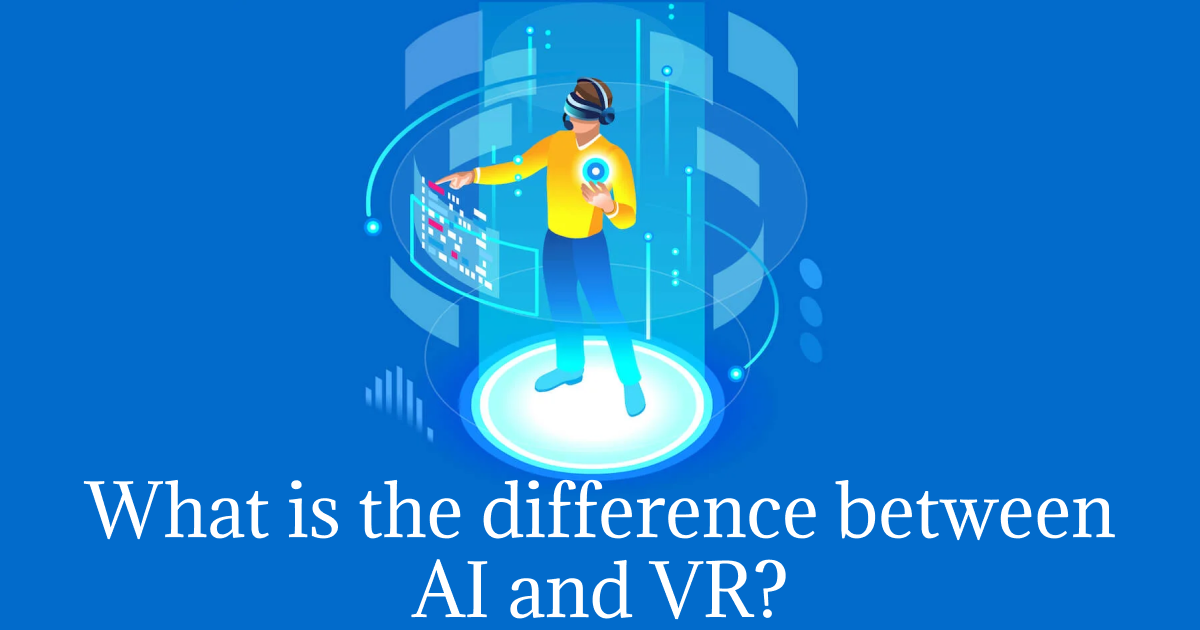Introduction
In the realm of cutting-edge technologies, two buzzwords frequently make headlines – AI and VR. While both are revolutionary in their own right, it’s crucial to understand the distinctions between them. In this blog, we will unravel the layers of AI and VR, step by step, to grasp their unique characteristics and applications. Two acronyms often find themselves in the spotlight: AI (Artificial Intelligence) and VR (Virtual Reality). Though distinct in their purposes, these technologies can intertwine to create powerful and immersive experiences. Let’s embark on a journey to understand the fundamental differences between AI and VR, unravelling their unique characteristics step by step.
Artificial Intelligence (AI)
Artificial Intelligence, commonly known as AI, refers to the simulation of human intelligence in machines programmed to think and learn like humans. The primary goal of AI is to enhance efficiency, automate tasks, and, in some cases, replicate human decision-making processes. Key components of AI include machine learning, natural language processing, and robotics.
Machine Learning in AI
One of the fundamental aspects of AI is machine learning. This involves algorithms that enable machines to learn from data, identify patterns, and make decisions without explicit programming. Machine learning is the driving force behind many AI applications, ranging from image recognition to personalized recommendations.
Artificial Intelligence, the marvel of computer science, delves into creating systems and algorithms with human-like intelligence. This involves tasks such as learning, reasoning, problem-solving, natural language understanding, and decision-making.
Nature of Technology
AI is centred around the development of systems capable of emulating human intelligence in various domains.
Purpose
Applied across diverse fields, AI finds its place in healthcare, finance, self-driving cars, and recommendation systems. It excels in natural language processing, image recognition, data analysis, and decision-making.
Interaction
While AI systems interact with users or data in real time, their primary focus is on processing and analyzing information rather than creating immersive experiences.
Technology Stack
Utilizing algorithms, machine learning, deep learning, and natural language processing, AI’s core lies in making predictions, decisions, and automating tasks.
Natural Language Processing (NLP)
Natural Language Processing (NLP) is another crucial element of AI. It empowers machines to understand, interpret, and generate human-like language. NLP is integral in voice recognition, chatbots, and language translation applications, making human-computer interactions more intuitive.
Virtual Reality (VR)
On the flip side, Virtual Reality (VR) is an immersive technology that creates a simulated environment, often using a computer-generated environment. Unlike AI, which focuses on intelligence and decision-making, VR is centered around providing a sensory experience, transporting users to a virtual world.
VR Hardware and Software
VR encompasses both hardware and software components. VR hardware, such as headsets and motion controllers, allows users to interact with the virtual environment. VR software includes the applications and programs that create and simulate the virtual experiences, ranging from gaming to educational simulations.
Virtual Reality, on the other hand, constructs immersive, computer-generated environments or simulations, aiming to transport users to virtual worlds.
Nature of Technology
VR revolves around creating environments that simulate reality, providing users with an immersive experience.
Purpose
Widely used in gaming, training simulations, architecture, education, and virtual tourism, VR aims to enhance and create interactive experiences.
Interaction
VR is all about user interaction and immersion, enabling individuals to enter and interact with computer-generated environments through sensory experiences.
Technology Stack
Involving hardware like headsets, motion controllers, and software for 3D environment creation, VR may also include haptic feedback devices to enhance immersion.
Applications of VR
The applications of VR are diverse and continually expanding. From gaming and entertainment to healthcare and education, VR is transforming various industries. It enables users to experience scenarios that may be impractical or unsafe in the real world, contributing to advancements in training simulations and therapeutic interventions.
Related post – Google’s Gemini AI
Bridging the Gap: AI and VR Integration
While distinct, AI and VR can complement each other, leading to more advanced and sophisticated solutions. Integrating AI within VR scenarios can bring intelligent behavior to virtual characters or objects, responding dynamically to user actions and adapting to changing situations.
Remember, when you navigate online car shopping and desire a 360-degree view, you are stepping into the immersive world of VR technology, where AI may also play a role behind the scenes, enhancing your experience. As technology continues to advance, the convergence of AI and VR promises a future where intelligence and immersion seamlessly coexist.
While AI and VR serve different purposes, there are instances where these technologies intersect. For example, AI can enhance the realism of VR experiences by providing more intelligent and responsive virtual characters. Additionally, AI algorithms can analyze user interactions in VR to personalize and adapt the virtual environment based on individual preferences.
Integration Scenarios
For instance, AI-powered chatbots within VR environments can offer personalized recommendations and support, showcasing the potential synergy between these technologies.
AI is about creating intelligent systems for performing tasks or analyzing data, while VR focuses on immersing users in computer-generated environments. Though different, when combined, they enrich VR experiences, infusing them with intelligent responses and dynamic content.
Embracing the potential of AI and VR integration opens up avenues for creating realistic and interactive virtual environments. The choice between AI and VR ultimately hinges on the specific needs and goals of a business. So, whether you’re exploring the depths of AI’s analytical prowess or diving into the immersive realms of VR, understanding their distinctions empowers you to harness their transformative potential.
Conclusion
AI and VR are distinct technologies with unique applications and focuses. AI revolves around intelligence and decision-making, while VR immerses users in simulated environments. By understanding the differences and recognizing their potential synergies, we can harness the power of both AI and VR to shape a future where technology enhances various aspects of our lives.








